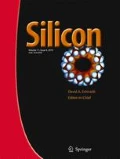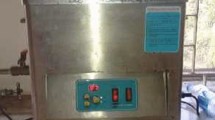Abstract
Machining of multidirectional Hybrid Fiber Reinforced Composite (HFRC) is a challenging task because of defects like matrix cracking, fiber pullouts, delamination, burr formation, and heat affected zones. The current study is focused on machining and characterization of in-house fabricated HFRC made of carbon and silica glass fiber using Abrasive Jet Machining (AJM). Machining of holes in fabricated multidirectional HFRC has been carried out using a set of input machining parameters -air pressure, abrasive grit size, and standoff distance. The output responses selected for the experiment are material removal rate, circularity, Depth Averaged Radial Overcut (DAROC), Taper Angle (TA), and Surface Roughness (Ra.) A novel technique has been contrived for measuring DAROC by using Computerized Tomography images. At the same time, the microstructure, surface roughness, and burr height of the machined samples are carried out using High-resolution Scanning Electron Microscope (HRSEM) images and 3D-profilometer images. Subsequently, the machining parameters are optimized using multi-objective GRA to strike a balance between the output parameters. The obtained results indicated the absence of defects like delamination, burr formation, heat affected zones in the machined samples. The outcome of the experiment corroborates the application suitability of the AJM process for machining multidirectional HFRC used in industrial and commercial products.
Similar content being viewed by others
References
Xu J, Mkaddem A, El M (2016) Recent advances in drilling hybrid FRP / Ti composite : a state-of-the-art review. Compos Struct 135:316–338. https://doi.org/10.1016/j.compstruct.2015.09.028
Kulkarni GS, Shivashankar GS, Suresh R, Siddeshkumar NG (2019) Optimization of drilling parameters of GFRP with liquid silicone rubber and fine silica powder by Taguchi approach. Silicon 14:1–16. https://doi.org/10.1007/s12633-019-00260-z
Leone C, Genna S (2018) Heat affected zone extension in pulsed Nd:YAG laser cutting of CFRP. Compos Part B Eng 140:174–182. https://doi.org/10.1016/j.compositesb.2017.12.028
Sheikh-Ahmad JY (2009) Machining of polymer composites springer, New York
Guu YH, Hocheng H, Tai NH, Liu SY (2001) Effect of electrical discharge machining on the characteristics of carbon fibre reinforced carbon composites. J Mater Sci 36:2037–2043. https://doi.org/10.1023/A:1017539100832
Kumar R, Agrawal PK, Singh I (2018) Fabrication of micro holes in CFRP laminates using EDM. J Manuf Process 31:859–866. https://doi.org/10.1016/j.jmapro.2018.01.011
Antil P (2020) Modelling and multi-objective optimization during ECDM of silicon carbide reinforced epoxy composites. Silicon 12(2):275–288. https://doi.org/10.1007/s12633-019-0078-3
Kumaran ST, Ko TJ, Kurniawan R, Li C, Uthayakumar M (2017) ANFIS modeling of surface roughness in abrasive waterjet machining of carbon fibre reinforced plastics. J Mech Sci Technol 31:3949–3954. https://doi.org/10.1007/s12206-017-0741-9
Voit M, Reinhart G, Metzger T (2017) Experimental study on water jet cutting of unidirectional carbon fibre fabrics. Proc CIRP 66:221–226. https://doi.org/10.1016/j.procir.2017.03.301
Caggiano A (2018) Machining of fibre reinforced plastic composite materials. Materials (Basel) 11(3):442. https://doi.org/10.3390/ma11030442
Madhu S, Balasubramanian M (2018) Impact of nozzle design on surface roughness of abrasive jet machined glass fibre reinforced polymer composites. Silicon 10(6):2453–2462. https://doi.org/10.1007/s12633-018-9777-4
Madhu S, Balasubramanian M (2017) Effect of abrasive jet process parameters on machining glass fibre reinforced polymer composite. Materialwiss Werkstofftech 48:1146–1157. https://doi.org/10.3390/ma11030442
Reddy SM, Hussain S, Srikanth DV, Rao DMS (2015) Experimental analysis and optimization of process parameters in machining of RCFRP by AJM. Int J Innov Res Sci Eng Technol 4:7085–7092. https://doi.org/10.15680/IJIRSET.2015.0408053
Zhang J, Chaisombat K, He S, Wang CH (2012) Hybrid composite laminates reinforced with glass/carbon woven fabrics for lightweight load bearing structures. Mater Des 36:75–80. https://doi.org/10.1016/j.matdes.2011.11.006
Singh MM, Kumar H, Kumar GH, Sivaiah P, Nagesha KV, Ajay KM, Vijaya G (2020) Determination of strength parameters of glass fibers reinforced composites for engineering applications. Silicon 12(1):1–11. https://doi.org/10.1007/s12633-019-0078-3
Abhishek K, Hiremath SS, Karunanidhi S (2018) A novel approach to produce holes with high degree of cylindricity through micro-abrasive jet machining (μ-AJM). CIRP J Manuf Sci Technol 21:110–119. https://doi.org/10.1016/j.cirpj.2018.02.002
Manders PW, Bader MG (1981) The strength of hybrid glass/carbon fibre composites - part 2 a statistical model. J Mater Sci 16:2246–2256. https://doi.org/10.1007/BF00542387
Gillespie LK (1996) Standard terminology for researchers of burrs and edge finishing. WBTC STD-02
Durao LMP, Tavaresde JMR, Magalhaes AG, Marques AT, Baptista APM (2008) Damage analysis of carbon/epoxy plates after drilling. https://repositorio-aberto.up.pt/handle/10216/5578
Tsao CC, Hocheng H (2005) Effects of exit back-up on delamination in drilling composite materials using a saw drill and a core drill. Int J Mach Tool Manu 45(11):1261–1270. https://doi.org/10.1016/j.ijmachtools.2005.01.015
Tsao CC, Hocheng H (2005) Computerized tomography and C-scan for measuring delamination in the drilling of composite materials using various drills. Int J Mach Tool Manu 45(11):1282–1287. https://doi.org/10.1016/j.ijmachtools.2005.01.015
Author information
Authors and Affiliations
Corresponding author
Additional information
Publisher’s Note
Springer Nature remains neutral with regard to jurisdictional claims in published maps and institutional affiliations.
Rights and permissions
About this article
Cite this article
Tomy, A., Hiremath, S.S. Machining and Characterization of Multidirectional Hybrid Silica Glass Fiber Reinforced Composite Laminates Using Abrasive Jet Machining. Silicon 13, 1151–1164 (2021). https://doi.org/10.1007/s12633-020-00504-3
Received:
Accepted:
Published:
Issue Date:
DOI: https://doi.org/10.1007/s12633-020-00504-3



